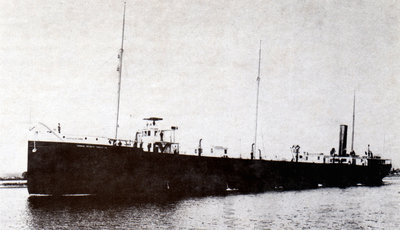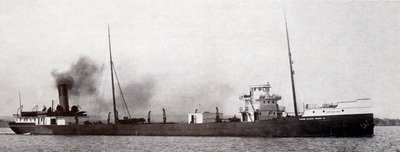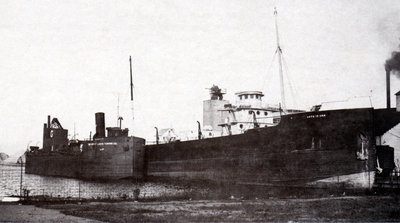Table of Contents
In the early years of Great Lakes shipping, most of the freight that was carried by boat was general cargo, or "package freight", that is, small consignments of packaged goods as well as the personal belongings of immigrants and other persons who were moving to the newly developed areas of the continent. Despite the rapid development of the movement of raw materials in bulk during the latter years of the nineteenth century, there was still a considerable movement of general cargo on the lakes, much of it being finished manufactured goods, and this trade remained strong during the first half of the new century. Indeed, it is really only in recent years that the package freight trade has almost died out on the lakes, with such cargo now being transported more economically by rail and road carriers.
The early lake package freighters were generally combination boats which also carried passengers but, by the turn of the century, there were many steel-hulled steamers which were designed and built solely for the carriage of general cargo. In most cases, those vessels were beautiful ships, with graceful lines and powerful engines that could ensure their operation on a tight schedule, for the lines that carried package freight profitably were those that could promise delivery at a specified port on a certain day.
One of the more interesting early steel-hulled package freighters was the steamer ARTHUR ORR (U.S.107005), which was built in 1893 at Chicago as Hull 7 of the Chicago Shipbuilding Company. As originally constructed, her hull was 286.0 feet in length, 41.3 feet in the beam, and 21.8 feet in depth, and her tonnage was calculated as 2329 Gross and 1972 Net. Steam was produced by two single-ended Scotch boilers, which measured 12 feet by 12 feet, and it powered a triple-expansion engine with cylinders of 19, 32 and 52 inches and a stroke of 44 inches. The machinery was built for the ship by the H. G. Trout Company of Buffalo, New York.
ARTHUR ORR was enrolled at Chicago. She was built for C. W. Elphicke and Company of Chicago, and she was named in honour of a senior member of the Elphicke firm. Orr, who died in 1925 at the age of 76, was a member of the insurance industry in Chicago, and his specialty was marine insurance. His operation had been merged into the Elphicke firm in 1885, and it was not surprising that Charles W. Elphicke named the new steamer for his business associate .

Fanjoy photo caught ARTHUR ORR upbound at the Soo during her very early years with the Canada Atlantic fleet.
It has been reported that, upon completion, ARTHUR ORR was chartered to the Goodrich Transit Company of Chicago for use as a passenger ferry on a route between downtown Chicago and the Columbian Exposition ("World's Fair"), the latter having been located at nearby Jackson Park. However, the authoritative history of the Goodrich Line (Red Stacks Over The Horizon, by James L. Elliott) makes no mention of any such operation of the ORR. Ourselves, we would tend to discount any suggestion that ARTHUR ORR was used for Exposition service, as she was completely unsuited for the passenger trade, having no passenger accommodations at all.
ARTHUR ORR was a handsome steamer, even though she was not blessed with the sweeping sheer that was sported by many of the later steel-hulled package freighters. She had a full forecastle with an open rail on its head and a closed rail extending down the spar deck for a short distance abaft the break of the forecastle. The bridge structure was set back off the forecastle, and consisted of a texas cabin, with a small pilothouse above it, and an open navigation bridge on the monkey's island. Full bridge wings extended out to the sides of the ship from both the lower and upper bridge decks. There were two "doghouses" on the spar deck, one abaft the bridge structure and one just forward of the boilerhouse, and these provided additional accommodation for the crew.
The after cabin was a large steel structure, with full windows in its sides and with a closed rail running around the flush quarterdeck to provide protection from the seas. The boat deck sported an overhang around the cabin, which extended out to the sides of the ship. The stack rose out of a boilerhouse which was not actually part of the after cabin, but which sat on the spar deck immediately forward of the main deckhouse. The lifeboats were set on the boat deck, one on each side, and were worked from radial davits.
ARTHUR ORR sported three masts, one of which rose just abaft the forecastle, one at about the mid-point of the spar deck, and one abaft the stack. These masts were tall, and were raked on the same sharp angle as was the fairly short and rather thin stack; none of these masts carried booms for the handling of freight. The ship was equipped with both deck hatches and side ports, and ten small derricks, lined up five per side, served to lift the steel plates which covered the side ports. (Package freighters of that era were not equipped with the hinged port doors that later came into fashion. )
C. W. Elphicke and Company operated ARTHUR ORR mainly on Lakes Michigan and Superior, in both the bulk and package freight trades. Steel vessels of that period were normally built with a multitude of stanchions and crossbeams in their holds to provide hull strength, and thus it was easy to install wooden planks to form 'tween decks for package freight, or to remove them as conditions might warrant. ARTHUR ORR apparently operated successfully for the Elphicke interests until 1898, when she suffered what appears to have been the only major accident of her career.
On Monday and Tuesday, November 21st and 22nd, 1898, there swept over Lake Superior a very severe gale. It caught in its path the ORR, which was downbound, laden with flour and copper below decks, and a deck load of shingles. The steamer was overcome by the storm and was driven ashore near the mouth of the Baptism River, some five miles northeast of Silver Bay Harbor, Minnesota. When the gale subsided, salvage crews came to the scene from Duluth, and they managed to refloat the ship. She was towed to Chicago, and there she was repaired during the winter of 1898-99. At the same time, she was lengthened to 334.0 feet, this reconstruction increasing her tonnage to 2745 Gross and 2117 Net.
It was in 1899 that ARTHUR ORR passed to the ownership of the firm in whose colours she was to operate for most of her life. A controlling interest in the ship was acquired by the newly formed Canada Atlantic Transit Company of Minnesota, although Elphicke and Company continued to have a hand in her day-to-day operation. The Canada Atlantic fleet had been organized as a subsidiary of John Rudolphus Booth's Canada Atlantic Railway, of Ottawa. This company operated a rail line between Depot Harbour, Ontario, (located on Parry Island in Georgian Bay, off the town of Parry Sound) and Ottawa (the nation's capitol), with connections to Montreal and also to the Central of Vermont Railroad. This through line had been completed in 1898(via Booth's Ottawa, Arnprior and Parry Sound Railway), but had its origins as far back as 1879. Not only was Booth in control of the Canada Atlantic, which was the largest privately owned railway in Canada, but he was also heavily involved in the lumber trade in Northern Ontario. He remained closely associated with his various business interests until he passed away at the age of 98 on December 8th, 1925.
The route of the new railway across Northern Ontario was a difficult one indeed, and there was considerable opposition to the route from a number of sources. In fact, one complaint against the location of the line stated that one of the areas through which the rails passed was "a complete wilderness, wholly uninhabited and of considerable distance from any settled district, but in the midst of Mr. J. R. Booth's timber limits". Regardless, Booth pressed through with the construction of his line, and chose Depot Harbour as its western terminus as, amongst other attributes, Depot Harbour possessed a fine natural harbour where docking facilities for lake vessels could easily be constructed.
By 1899. a large grain elevator, with a capacity of 1,000,000 bushels, was ready for operation at Depot Harbour. A 1,000,000 bushel addition to the elevator was constructed in 1906-07, as the route from the lakes to the east coast, via Depot Harbour and the Canada Atlantic line, was by far the shortest route for export grain, and thus attracted considerable traffic. Much coal was brought by boat to Depot Harbour and, as well, large quantities of package freight and lumber were shipped out of the port on lake vessels. Spacious freight sheds were constructed at Depot Harbour, and they were reached via a 2,300 foot long double-tracked trestle. The harbour site, which was nothing at all until Booth chose it as the terminus for his railway, became a thriving town, completely oriented around the operations of the rail line. The town itself was built on land leased from a local Indian reservation.
In addition to ARTHUR ORR, the Canada Atlantic Transit Company also acquired the steamers GEORGE N. ORR and KEARSARGE, and built the OTTAWA and NEWONA. As well, several other vessels were chartered, as required, from other operators. Despite the passage of the years, the lake steamers continued to run under the Canada Atlantic Transit name, although the parent railway company was taken over in 1905 by the Grand Trunk Railway System, and in 1923 became part of the Canadian National Railways.
ARTHUR ORR operated from the ports of Duluth and Chicago to Depot Harbour, although after the first few years she became a regular on the route between Chicago, Milwaukee and Depot Harbour. The steamer was modernized in appearance as the years passed, and a large cabin containing accommodation for the master was located atop the old texas. Above this new structure was built a new pilothouse with seven widely-spaced windows in its rounded front. The second doghouse was removed from the spar deck, and the boilerhouse was joined to the after cabin. A new stack, rather thicker and shorter than the original, and with a more marked rake, was added. The mainmast was relocated farther aft on the spar deck, and the mizzen was removed completely. Probably because it tended to "trap" boarding seas, the boat deck overhang around the after cabin was removed, although the closed taffrail around the quarterdeck was retained.
The steamer was painted up in what became the traditional colours of the Canada Atlantic boats. Her hull was black, as was the taffrail and also the closed deck rail forward. Her cabins were white, as also was the upper section of the forecastle, complete with the two-tiered closed rail which had been added at its forward end. (In later years, the forecastle became black and only its closed rail remained white.) Her stack was painted a dark buff, with a wide black smokeband at the top.

ARTHUR ORR was downbound in Little Rapids Cut when this Young photo was taken in 1923.
Despite the fact that the Canada Atlantic Railway and its successors were always under Canadian ownership, ARTHUR ORR and her running mates, KEARSARGE and GEORGE N. ORR, remained under United States registry throughout their careers with the fleet, and thus were not permitted to trade between Canadian ports. In 1926, however, two Canadian-registered vessels were added to the fleet, these being the steamers CANATCO, (a) CANADIAN GUNNER (26), and DALWARNIC, (a) CANADIAN HARVESTER (26). They were built during the early 1920s as part of the Canadian Government Merchant Marine fleet which had been established during the First World War to provide additional tonnage for the war effort. The vessels of the government fleet were sold off during the 1920s, and found their way into a number of privately owned companies.
CANATCO and DALWARNIC remained under Canadian registry as long as they served the Canada Atlantic Transit Company, being operated by a separate Canadian affiliate. Built along salt-water lines (rather like Canadian versions of the famous American "Lakers" of World War One), these steamers ran successfully for many years. Unfortunately, however, DALWARNIC is best known for the fact that, on May 31st, 1926, whilst on her delivery voyage into the lakes, she ran down and sank the Canadian canaller NISBET GRAMMER, which was owned by the Eastern Steamship Company Ltd. The collision occurred on Lake Ontario during a dense fog.
With the addition of CANATCO and DALWARNIC to the Canada Atlantic fleet, the other steamers, including ARTHUR ORR, became less important to the company than they had been earlier. The older vessels continued to serve the package freight line, but they operated less frequently and only as required. This was especially true during the years of the Great Depression, when cargoes were much less easily obtained.
The line suffered a severe setback with the advent of the Second World War, however, and did not survive that conflict. Its two best boats, CANATCO and DALWARNIC, were requisitioned by the Canadian government for service on the east coast, and they never returned to lake service. The last two ships in the fleet were KEARSARGE and ARTHUR ORR, and they operated until they were sold out of the company during the early 1940s.
It was in 1942 that the Canada Atlantic Transit Company of the United States (as her registered owner was known) sold ARTHUR ORR to the Overlakes Freight Corporation, of Detroit. Overlakes, of course, was the successor to the Nicholson Universal Steamship Company, which had been formed back in 1922 by Captain William Nicholson. Control of the fleet had passed to the New York Central Railroad after Nicholson sold his interest in 1927, and Overlakes came onto the scene in the operation of the fleet after the U.S. government forced the New York Central to divest itself of the shipping line so as to be in compliance with the requirements of the Panama Canal Act. Troy H. Browning of Detroit eventually gained control of the Overlakes fleet, and in 1947 ARTHUR ORR was transferred to the T. H. Browning Steamship Company, of Trenton, Michigan.
The Browning Line, as it was known, owned an interesting collection of older vessels, but most had been modernized at least to the point that they could still operate economically. ARTHUR ORR, however, did not fall into this category, the passing years having taken their toll on her condition. The steamer had not been given any major refurbishing for many years and, in fact, looked much as she had for several decades. Accordingly, it was determined that conditions did not then warrant any major expenditure of funds on the ship and, in June of 1947, while she was lying idle at Detroit ARTHUR ORR was sold to the Steel Company of Canada Ltd. for scrapping. Taken in tow by the big steam tug HELENA, the ORR arrived at the Wellington Street slip in Hamilton during July 1947, and she was finally dismantled by the Stelco breakers in April of 1948.

ARTHUR ORR was at Hamilton, waiting to be scrapped, when Jim Kidd photographed her on November 2, 1947. Alongside was the retired lighter RESCUE.
No reminder today exists of the Canada Atlantic Transit Company's operations. After the cessation of the line's services in 1942, even Depot Harbour fell on hard times. The grain elevator and the freight sheds there were used to store cordite after the steamers ceased calling and, as might have been expected, this use of the old buildings had disastrous results. In 1945. parts of the grain elevator were being demolished, although quantities of cordite were still on the premises. On the evening of V-J Day (Tuesday, August 14th, 1945). the remains of the elevator were torched by arsonists (or, perhaps, overenthusiastic revellers), and a tremendous explosion and fire ensued. The elevator was completely destroyed in the conflagration, and sparks blew across the harbour and set fire to the freight sheds as well, and they also were levelled.
For a few years, coal and iron ore were shipped via Depot Harbour, but all shipping activities at the port ceased during the 1970s, and only rusting dock equipment remains there today. The townsite itself has reverted to brushland, much as it was in the days before John Rudolphus Booth's railway (itself just a memory) came to the area, bringing with it years of civilization and prosperity.
Ed Note: Those wishing to learn more about the rail operations of the Canada Atlantic Railway would do well to read Over The Hills To Georgian Bay, by Niall MacKay, published in 1981 by The Boston Mills Press, Erin, Ont.
Previous Next
Return to Home Port or Toronto Marine Historical Society's Scanner
Reproduced for the Web with the permission of the Toronto Marine Historical Society.